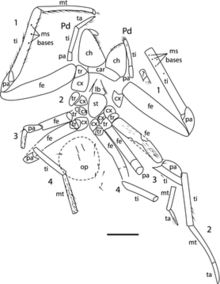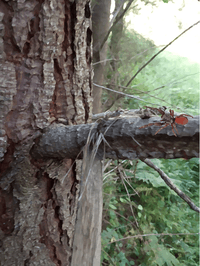Seppo koponeni
Seppo is an extinct genus of spiders, possibly of the superfamily Palpimanoidea, that lived about 180 million years ago, in the Early Jurassic (Lower Toarcian) of what is now Europe. The sole species Seppo koponeni is known from a single fossil from Grimmen, Germany.[1] With the scorpion Liassoscorpionides, it is one of the two only known arachnids from the Lower Jurassic of Germany.[1] Seppo is the First unequivocal Early Jurassic Spider, and was recovered from the Green Series member of the Toarcian Ciechocinek Formation.[1]
| Seppo koponeni | |
|---|---|
 | |
| Holotype and only known specimen MB.A 2966. | |
| Scientific classification | |
| Kingdom: | Animalia |
| Phylum: | Arthropoda |
| Subphylum: | Chelicerata |
| Class: | Arachnida |
| Order: | Araneae |
| Infraorder: | Araneomorphae |
| Family: | incertae sedis |
| Genus: | †Seppo Selden & Dunlop, 2014 |
| Species: | †S. koponeni |
| Binomial name | |
| †Seppo koponeni Selden & Dunlop, 2014 | |
Description
The spider was described from single female specimen, that is unkonow if was an Adult.[1] The Carapace is unknown, and besides that has preserved bowed converging sides with a curved posterior margin with straight posterior border of the labium , with row of at least 12 peg teeth along Cheliceral Furrow, no true teeth, scattered setae on anterior surface, slender Pedipalps.[1] Legs are preserved, being the I, II much longer than III, IV, and all well covered in setae and bristles, especially on the tibiae and metatarsi of leg I.[1] It most likely belongs to the Palpimanoidea, on account specially of the presence of cheliceral peg teeth.[1]
Discovery
The single Know specimen was found on locality known for its fossil insects in Grimmen, near Greifswald, at the north of Germany.[1] It was reported in 2003, when Ansorge did a recopilation of Insect Taxa on the Toarcian strata of Germany and England.[2] The Specimen was recovered from the Falciferum zone (Exaratum subzone), c. 180 Ma, and presented as "Araneae gen. et sp. nov." (Chelicerata).[2] It was recovered from a fragment of calcareous nodule from the grey-green Claystone, recovered from the closed since the 90´s Clay Pit of Klein Lehmhagen, near Grimmen, Western Pomerania, Germany.[2][1] It is curious for be one of the rare few examples of Spiders found on Calcium Carbonate (Along with others from the Eocene Limestone of the Isle of Wight, England[3]). The specimen was found with some parts preserved as external moulds, and these show Setation and Spination, being this as an exception, since mostly of the specimen is an internal mould of calcium carbonate.[1] The Specimen was labeled with the number MB.A 2966, and deposited in the Museum für Naturkunde, Berlin, being named in 2014 by Paul A. Selden & Jason A. Dunlop Seppo koponeni, after the Finish Arachnologist Seppo Koponen, to celebrate his 70th birthday.[1]
Ecology

Seppo koponeni is one of the only two arachnids ever to have been found in the Toarcian rocks of north Germany, outnumbered by several thousand insect specimens at several localities.[4][1] The different between the number of insects as opposed to arachnids has not been studied in depth. A possibility is that because insects can fly over water, they fall into it far more easily than spiders.[5][1] It is unclear how the spider ended on a marine clay deposit, far from the land, although several theories have been suggested: ballooning is a possibility as a method of transport, perhaps helped by severe storms, hurricanes, and tornadoes.[1] Another possibility might be that it was carried out to sea on floating vegetation, as wood remains have been recovered in the deposit.[1]
On nearby land, ground dwellers were represented by arachnids, such as Seppo and scorpions, but also by Gryllidae, such as Protogryllus dobbertinensis, grylloblattodeans such as Nele jurassica, and dermapterans.[2] These arthropods never moved far from where they lived and are generally very rare in the rocks.[2] Seppo shows a rather unusual morphology, with large and porrect chelicerae and a robust leg I, contrasted with a short leg III.[1] The robust and well-armed first legs, directed forwards, give the impression that they were prey capture appendages, a morphology typical of a sit-and-wait predator, while the short third legs are more typical of web spiders, especially orbweavers, but also palpimanoids. Short third legs are not usually found on spiders that are substrate dwellers, which have more equal legs.[1] Seppo was probably not a habitual ground dweller. The armoured front legs related to capturing dangerous prey are typical of many extant palpimanoids that are araneophagous.[1]
References
- Selden, Paul A.; Dunlop, Jason A. (2014). "The first fossil spider (Araneae: Palpimanoidea) from the Lower Jurassic (Grimmen, Germany)". Zootaxa. 3894 (1): 161–168. doi:10.11646/zootaxa.3894.1.13. PMID 25544628.
- Ansorge, J. (2003) Insects from the Lower Toarcian of Middle Europe and England. Acta Zoologica Cracoviensia, 46 (suppl. -Fossil Insects), 291–310
- Selden, P.A. (2001) Eocene spiders from the Isle of Wight with preserved respiratory structures. Palaeontology, 44, 695 729.http://dx.doi.org/10.1111/1475-4983.00199
- Ansorge, J. (2007) Liastongrube Grimmen. Biuletyn Państwowego Instytutu Geologicznego, 424, 37–41.
- Selden, P.A., Anderson, H.M. & Anderson, J.M. (2009) A review of the fossil record of spiders (Araneae) with special reference to Africa, and description of a new specimen from the Triassic Molteno Formation of South. African Invertebrates, 50, 105–116